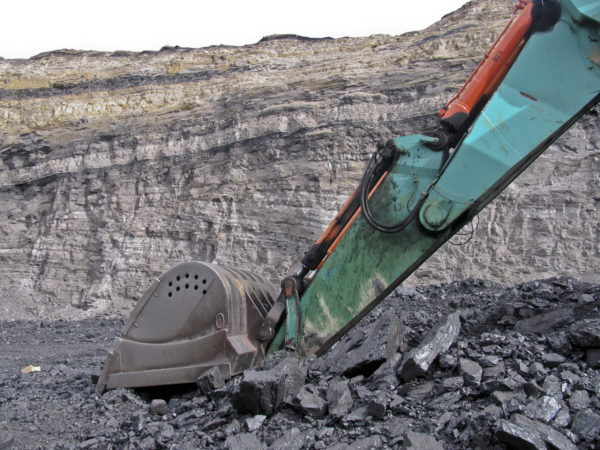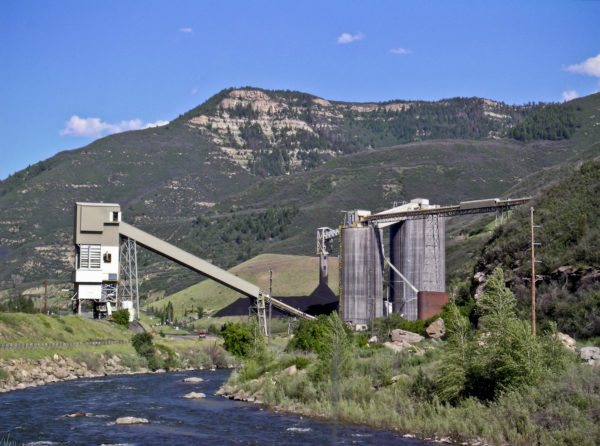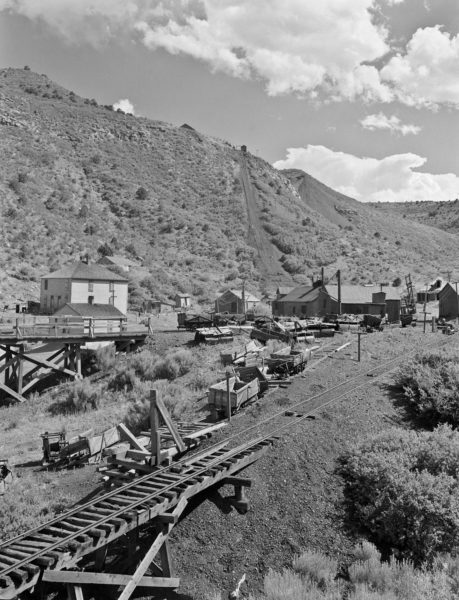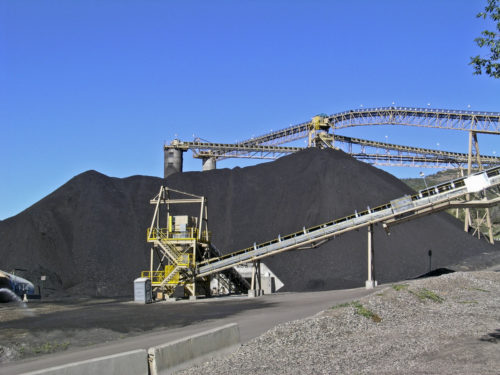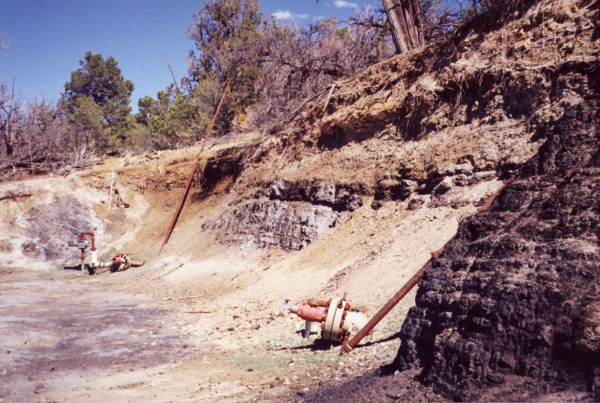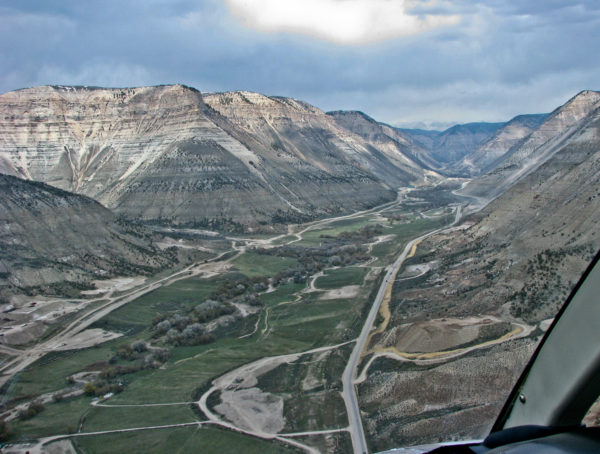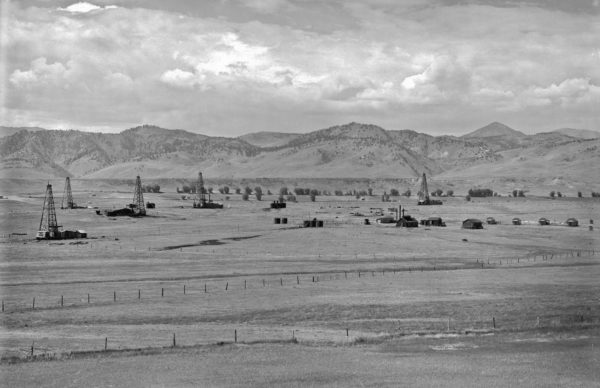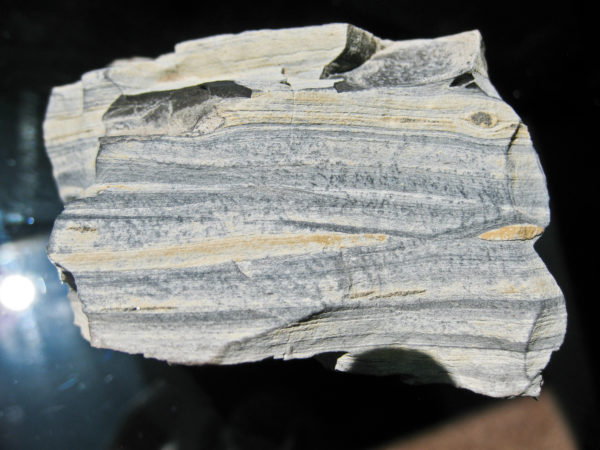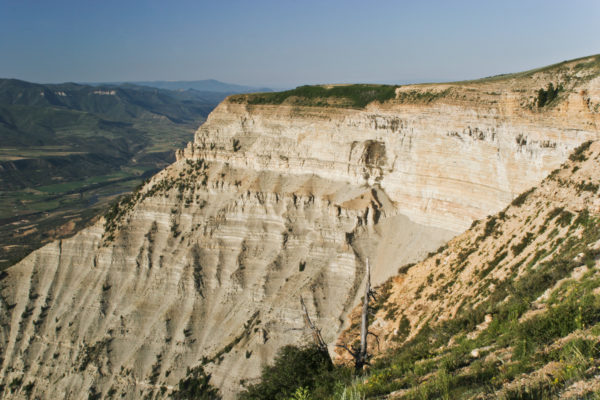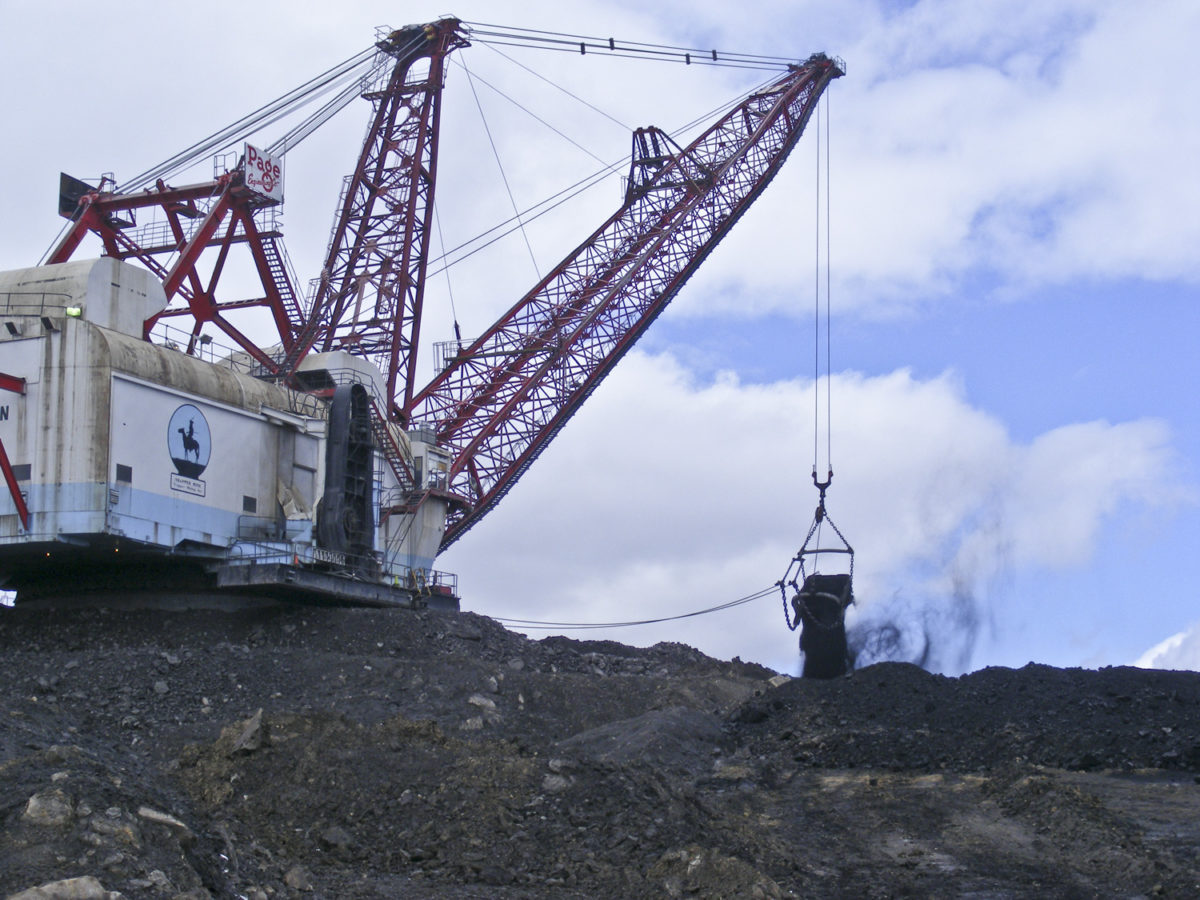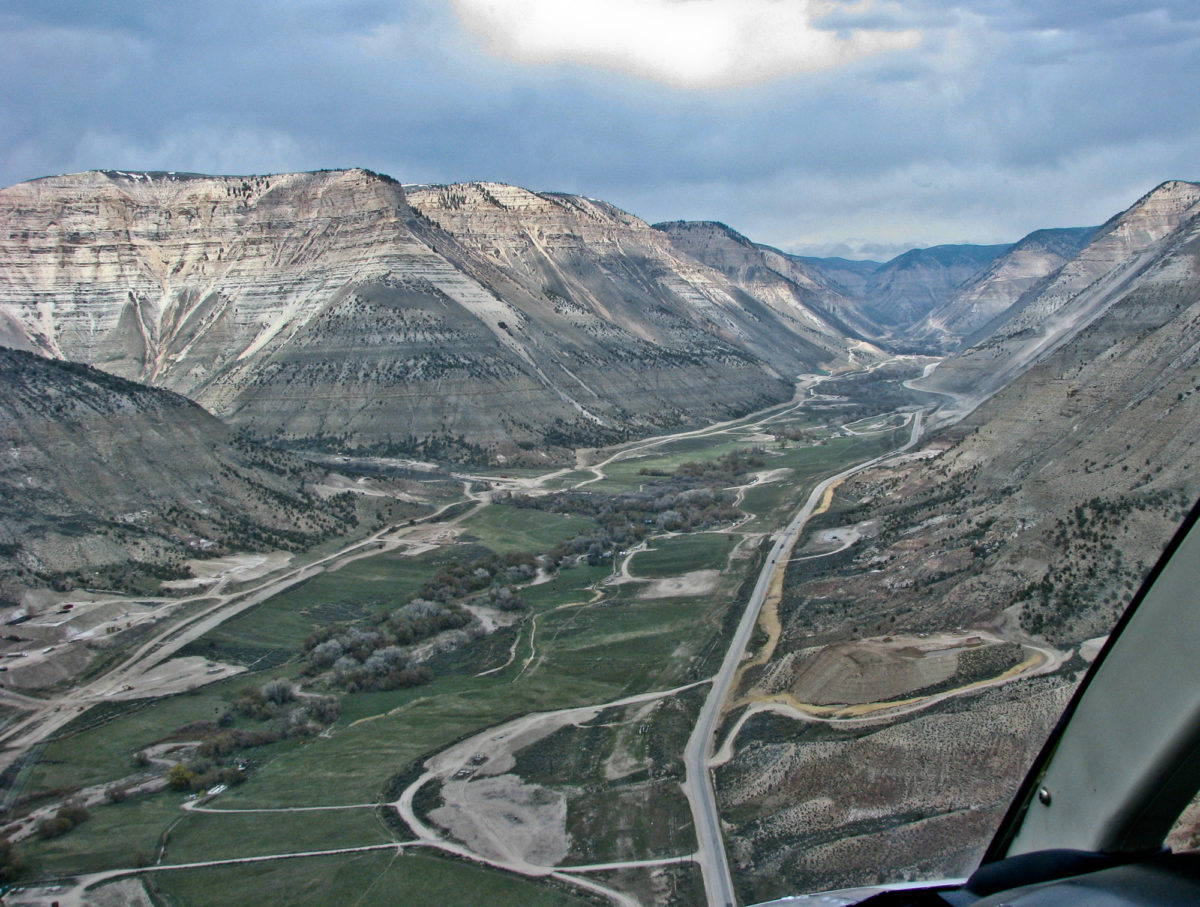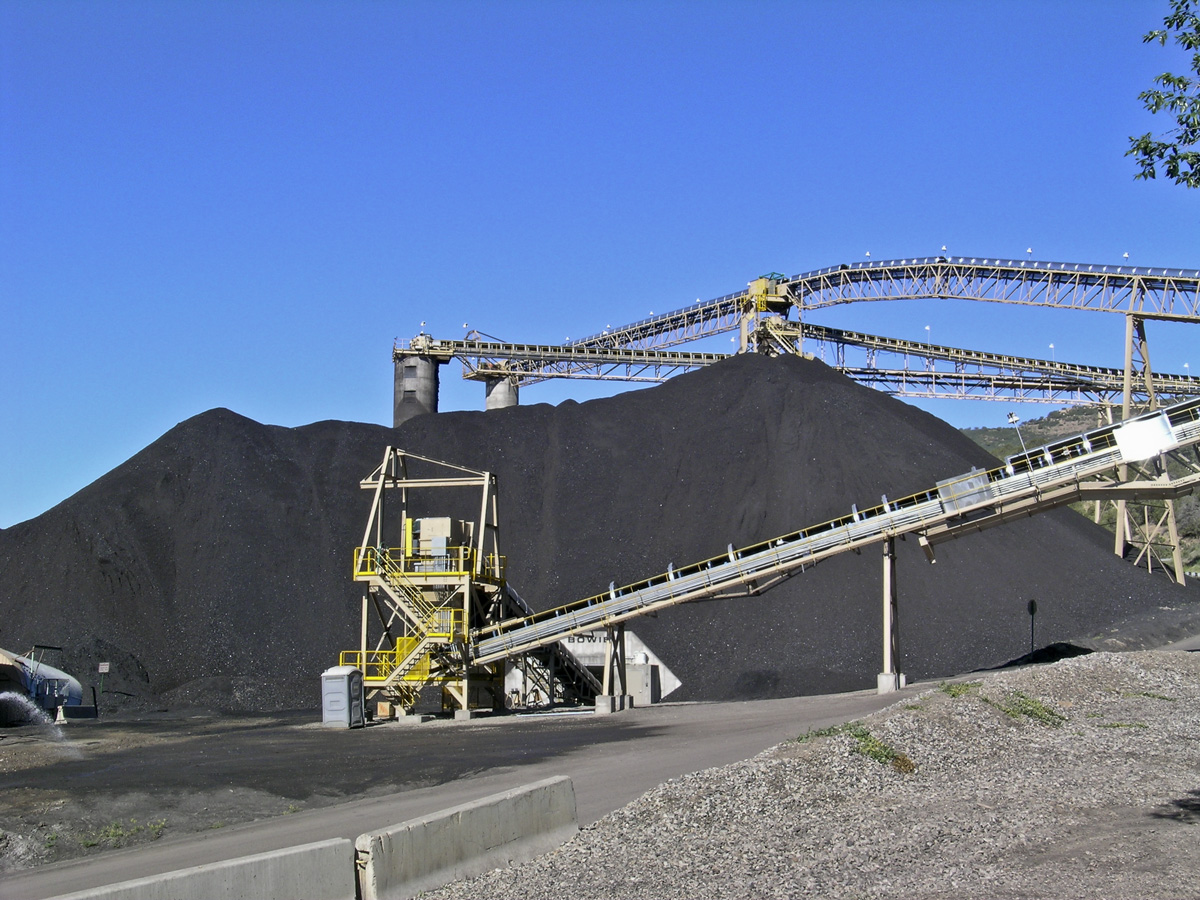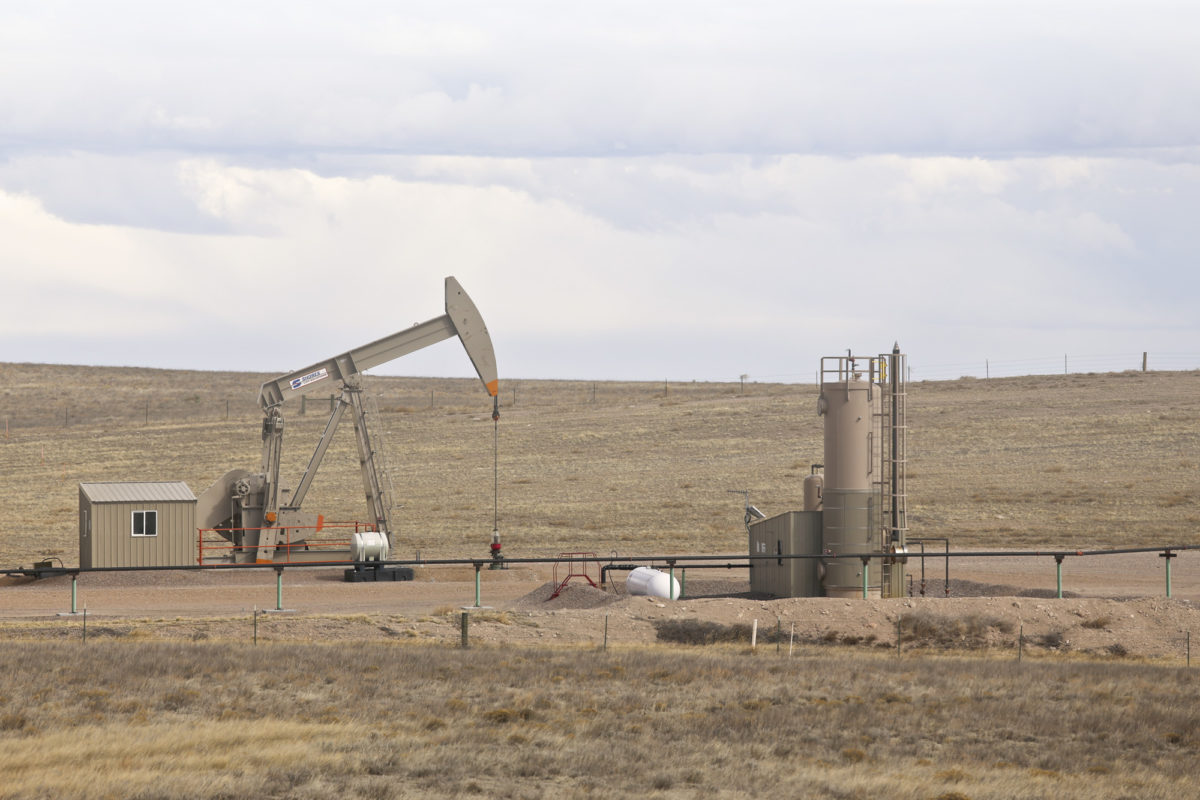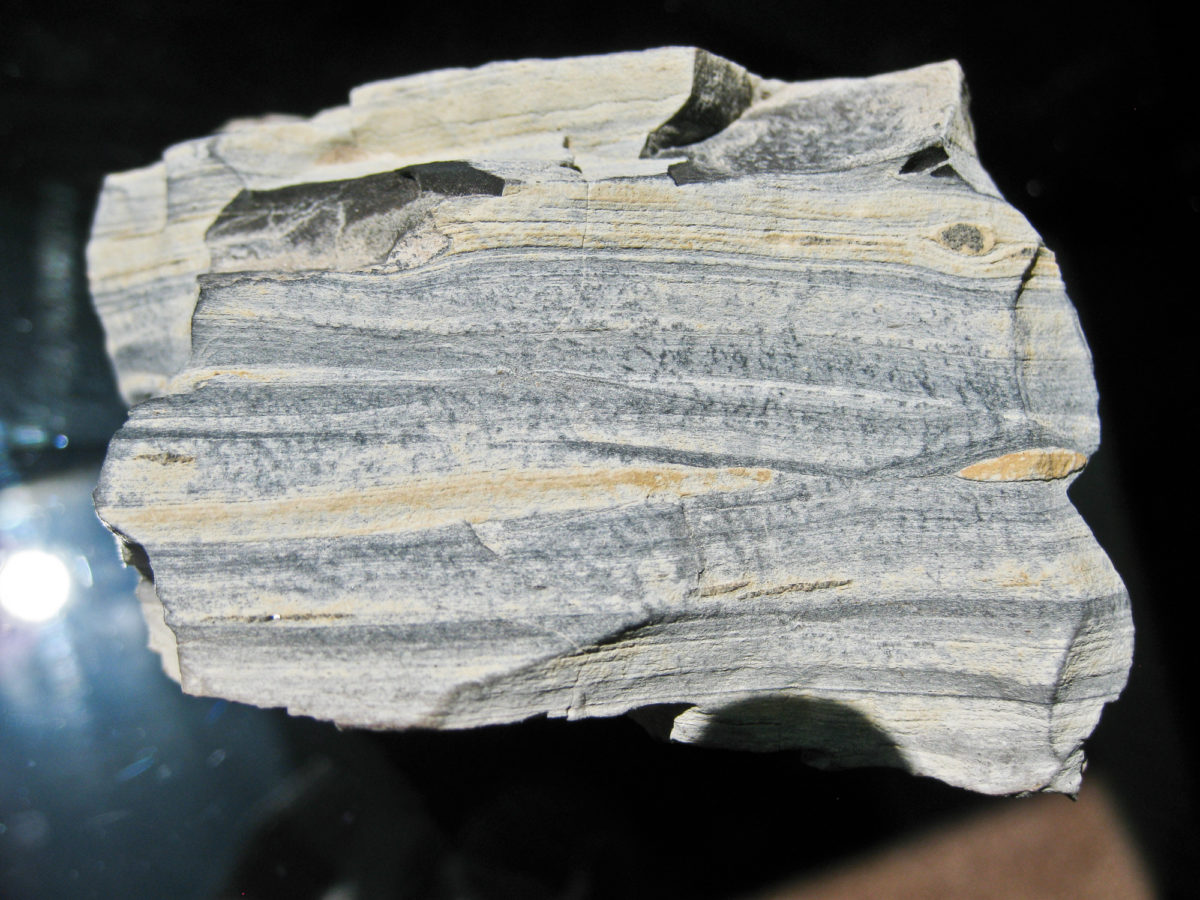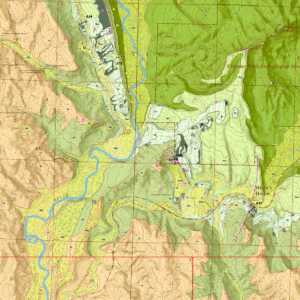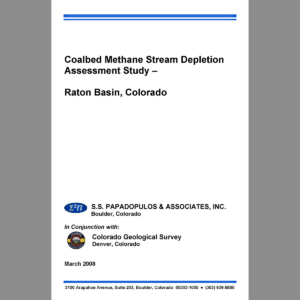Ambrose, Carol M. T. “RS-34 Penetration Chart of Selected Colorado Oil and Gas Fields.” Penetration Charts. Resource Series. Denver, CO: Colorado Geological Survey, Department of Natural Resources, 1998.
https://coloradogeologicalsurvey.org/publications/penetration-charts-oil-gas-fields-colorado.
Berkman, Frederick E., Paul Morgan, and Nicholas A. Watterson. “MS-48 Oil and Gas Wells in Areas of Colorado with Superior Geothermal Properties.” Geothermal, 1:500,000. Map Series. Denver, CO: Colorado Geological Survey, Department of Natural Resources, March 2010.
https://coloradogeologicalsurvey.org/publications/oil-gas-wells-geothermal-colorado.
Burnell, James R., Christopher J. Carroll, and Genevieve Young. “IS-77 Colorado Mineral and Energy Industry Activities, 2007.” Mineral and Energy Industry. Information Series. Denver, CO: Colorado Geological Survey, Department of Natural Resources, 2008.
https://coloradogeologicalsurvey.org/publications/colorado-mineral-energy-industry-activities-2007.
Cappa, James A., Christopher J. Carroll, and H. Thomas Hemborg. “IS-52 Colorado Mineral and Mineral Fuel Activity, 1998.” Mineral and Mineral Fuel. Information Series. Denver, CO: Colorado Geological Survey, Department of Natural Resources, 1999.
https://coloradogeologicalsurvey.org/publications/colorado-minerals-fuel-activity-1998.
———. “IS-54 Colorado Mineral and Mineral Fuel Activity, 1999.” Mineral and Mineral Fuel. Information Series. Denver, CO: Colorado Geological Survey, Division of Minerals and Geology, Department of Natural Resources, 2000.
https://coloradogeologicalsurvey.org/publications/colorado-minerals-fuel-activity-1999.
Cappa, James A., Wynn Eakins, and H. Thomas Hemborg. “IS-44 Colorado Mineral and Mineral Fuel Activity, 1997.” Mineral and Mineral Fuel. Information Series. Denver, CO: Colorado Geological Survey, Department of Natural Resources, 1998.
https://coloradogeologicalsurvey.org/publications/colorado-minerals-fuel-activity-1997.
Cappa, James A., H. Thomas Hemborg, and Rachel Coursey. “OF-01-06 Evaluation of Mineral and Mineral Fuel Potential of Grand and Summit Counties State Mineral Lands Administered by the Colorado State Land Board.” Mineral and Mineral Fuel. Open File Report. Denver, CO: Colorado Geological Survey, Division of Minerals and Geology, Department of Natural Resources, January 2001.
https://coloradogeologicalsurvey.org/publications/evaluation-mineral-fuel-potential-grand-summit-cslb.
Cappa, James A., H. Thomas Hemborg, John W. Keller, and Rachel Coursey. “OF-00-19 Evaluation of Mineral and Mineral Fuel Potential of Boulder, Jefferson, Clear Creek, and Gilpin Counties State Mineral Lands Administered by the Colorado State Land Board.” Mineral and Mineral Fuel. Open File Report. Denver, CO: Colorado Geological Survey, Division of Minerals and Geology, Department of Natural Resources, 2000.
https://coloradogeologicalsurvey.org/publications/evaluation-mineral-fuel-potential-boulder-jefferson-clear-creek-gilpin-cslb.
Cappa, James A., and John W. Keller. “OF-00-08 Evaluation of Mineral and Mineral Fuel Potential of Teller County State Mineral Lands Administered by the Colorado State Land Board.” Mineral and Mineral Fuel. Open File Report. Denver, CO: Colorado Geological Survey, Division of Minerals and Geology, Department of Natural Resources, 2000.
https://coloradogeologicalsurvey.org/publications/evaluation-mineral-fuel-potential-teller-cslb.
Cappa, James A., Nicole V. Koenig, and Rachel Coursey. “OF-01-15 Evaluation of Mineral and Mineral Fuel Potential of Jackson County State Mineral Lands Administered by the Colorado State Land Board.” Mineral and Mineral Fuel. Open File Report. Denver, CO: Colorado Geological Survey, Division of Minerals and Geology, Department of Natural Resources, July 2001.
https://coloradogeologicalsurvey.org/publications/evaluation-mineral-fuel-potential-jackson-cslb.
Cappa, James A., Nicole V. Koenig, and Rachel E. Garrison. “OF-01-21 Evaluation of Mineral and Mineral Fuel Potential of Larimer County State Mineral Lands Administered by the Colorado State Land Board.” Mineral and Mineral Fuel. Open File Report. Denver, CO: Colorado Geological Survey, Division of Minerals and Geology, Department of Natural Resources, December 2001.
https://coloradogeologicalsurvey.org/publications/evaluation-mineral-fuel-potential-larimer-cslb.
Cappa, James A., Michael K. O’Keeffe, James R. Guilinger, and Karen A. Berry. “IS-79 Colorado Mineral and Energy Industry Activities 2015-2016.” Mineral and Energy Industry. Information Series. Golden, CO: Colorado Geological Survey, 2016.
https://coloradogeologicalsurvey.org/publications/colorado-mineral-energy-industry-activities-2016.
Cappa, James A., L. Alex Scarbrough, Jr., Harry TerBest, and H. Thomas Hemborg. “OF-99-15 Evaluation of Mineral and Mineral Fuel Potential of Park County State Mineral Lands Administered by the Colorado State Land Board.” Mineral and Mineral Fuel. Open File Report. Denver, CO: Colorado Geological Survey, Division of Minerals and Geology, Department of Natural Resources, 1999.
https://coloradogeologicalsurvey.org/publications/evaluation-mineral-fuel-potential-park-cslb.
Cappa, James A., and Harry TerBest. “OF-02-23 Evaluation of Mineral and Mineral Fuel Potential of Weld County State Mineral Lands Administered by the Colorado State Land Board.” Mineral and Mineral Fuel. Open File Report. Denver, CO: Colorado Geological Survey, Division of Minerals and Geology, Department of Natural Resources, December 2002.
https://coloradogeologicalsurvey.org/publications/evaluation-mineral-fuel-potential-weld-cslb.
Cappa, James A., Harry TerBest, and Nicole V. Koenig. “OF-03-11 Evaluation of Mineral and Mineral Fuel Potential of Adams, Arapahoe, and Denver Counties State Mineral Lands Administered by the Colorado State Land Board.” Mineral and Mineral Fuel. Open File Report. Denver, CO: Colorado Geological Survey, Division of Minerals and Geology, Department of Natural Resources, April 2003.
https://coloradogeologicalsurvey.org/publications/evaluation-mineral-fuel-potential-adams-arapahoe-denver-cslb.
Cappa, James A., and Carol M. Tremain. “IS-39 Colorado Mineral and Mineral Fuel Activity, 1994.” Mineral and Mineral Fuel. Information Series. Denver, CO: Colorado Geological Survey, Division of Minerals and Geology, Department of Natural Resources, 1995.
https://coloradogeologicalsurvey.org/publications/colorado-minerals-fuel-activity-1994.
———. “IS-40 Colorado Mineral and Mineral Fuel Activity, 1995.” Mineral and Mineral Fuel. Information Series. Denver, CO: Colorado Geological Survey, Division of Minerals and Geology, Department of Natural Resources, 1996.
https://coloradogeologicalsurvey.org/publications/colorado-minerals-fuel-activity-1995.
Cappa, James A., Carol M. Tremain, and H. Thomas Hemborg. “IS-42 Colorado Mineral and Mineral Fuel Activity, 1996.” Mineral and Mineral Fuel. Information Series. Denver, CO: Colorado Geological Survey, Department of Natural Resources, 1997.
https://coloradogeologicalsurvey.org/publications/colorado-minerals-fuel-activity-1996.
Cappa, James A., Beth Widmann, Christopher J. Carroll, John W. Keller, and Genevieve Young. “IS-69 Colorado Mineral and Mineral Fuel Activity, 2003.” Mineral and Mineral Fuel. Information Series. Denver, CO: Colorado Geological Survey, Division of Minerals and Geology, Department of Natural Resources, 2003.
https://coloradogeologicalsurvey.org/publications/colorado-minerals-fuel-activity-2003.
Cappa, James A., Genevieve Young, James R. Burnell, Christopher J. Carroll, and Beth Widmann. “IS-75 Colorado Mineral and Energy Industry Activities, 2006.” Mineral and Energy Industry. Information Series. Denver, CO: Colorado Geological Survey, Department of Natural Resources, 2007.
https://coloradogeologicalsurvey.org/publications/colorado-mineral-energy-industry-activities-2006.
Cappa, James A., Genevieve Young, John W. Keller, Christopher J. Carroll, and Beth Widmann. “IS-70 Colorado Mineral and Mineral Fuel Activity, 2004.” Mineral and Mineral Fuel. Information Series. Denver, CO: Colorado Geological Survey, Division of Minerals and Geology, Department of Natural Resources, 2005.
https://coloradogeologicalsurvey.org/publications/colorado-minerals-fuel-activity-2004.
———. “IS-73 Colorado Mineral and Energy Industry Activities, 2005.” Mineral and Energy Industry. Information Series. Denver, CO: Colorado Geological Survey, Division of Minerals and Geology, Department of Natural Resources, 2005.
https://coloradogeologicalsurvey.org/publications/colorado-mineral-energy-industry-activities-2005.
Carroll, Christopher J., James A. Cappa, John W. Keller, Beth Widmann, L. L. Wray, and Thomas J. Hyde. “IS-63 Colorado Mineral and Mineral Fuel Activity, 2001.” Mineral and Mineral Fuel. Information Series. Denver, CO: Colorado Geological Survey, Division of Minerals and Geology, Department of Natural Resources, 2001.
https://coloradogeologicalsurvey.org/publications/colorado-minerals-fuel-activity-2001.
Colorado Geological Survey. “OF-73-01 Geology and Mineral Resources of LAVCOG Planning District 6: Surficial Deposits; Groundwater Resources; Oil & Gas Fields and Major Geologic Features; and Mineral Resources.” Mineral Resources. Open File Reports. Denver, CO: Colorado Geological Survey, Department of Natural Resources, 1973.
https://coloradogeologicalsurvey.org/publications/geology-mineral-resources-planning-district-6.
Colorado Geological Survey. “OF-05-09 Shapefiles for 2002 Oil and Gas Fields Map of Colorado.” Oil and Gas Fields, 1:500,000. Open File Report. Denver, CO: Colorado Geological Survey, Division of Minerals and Geology, Department of Natural Resources, 2005.
https://coloradogeologicalsurvey.org/publications/shapefiles-oil-gas-fields-map-colorado.
Fitzgerald, F. Scot, Chris Eisinger, and James J. Milne. “MS-44 Oil and Gas Wells Map of Colorado.” Oil and Gas Wells, 1:500,000. Map Series. Denver, CO: Colorado Geological Survey, 2015.
https://coloradogeologicalsurvey.org/publications/oil-gas-wells-map-colorado-2015.
George, R. D. “MI-21 Oil Map of Colorado (Showing the Proved Oil Fields, Oil Shale Deposits, Location of Anticlinal Structures, Oil & Gas Seepages, and Ther Indications of Oil & Gas).” Oil. Miscellaneous Investigations. Boulder, CO: Colorado State Geological Survey, 1925.
https://coloradogeologicalsurvey.org/publications/oil-map-colorado.
Guilinger, James R., and John W. Keller. “IS-78 Colorado Mineral and Energy Industry Activities 2014-2015.” Mineral and Energy Industry. Information Series. Golden, CO: Colorado Geological Survey, 2015.
https://coloradogeologicalsurvey.org/publications/colorado-mineral-energy-industry-activities-2015.
Hemborg, H. Thomas. “MS-30 Basement Structure Map of Colorado with Major Oil and Gas Fields.” Basement Structure, 1:1,000,000. Map Series. Denver, CO: Colorado Geological Survey, Department of Natural Resources, 1996.
https://coloradogeologicalsurvey.org/publications/basement-structure-map-major-oil-gas-colorado.
Hemborg, H. Thomas, and John W. Keller. “OF-00-14 Preliminary Evaluation of Mineral and Mineral Fuel Potential of the 68 Tracts of State Trust Land Nominated by the Public for Inclusion in the Stewardship Trust (Round 2).” Mineral and Mineral Fuel. Open File Report. Denver, CO: Colorado Geological Survey, Division of Minerals and Geology, Department of Natural Resources, May 2000.
https://coloradogeologicalsurvey.org/publications/evaluation-mineral-fuel-potential-68-tracts-cslb.
Hemborg, H. Thomas, and Harry Terbest. “OF-98-06 Preliminary Evaluation of Mineral and Mineral Fuel Potential of the 130 Tracts of State Trust Land Nominated by the Public for Inclusion in the Stewardship Trust (Round 1).” Mineral and Mineral Fuel. Open File Report. Denver, CO: Colorado Geological Survey, Division of Minerals and Geology, Department of Natural Resources, 1998.
https://coloradogeologicalsurvey.org/publications/preliminary-evaluation-mineral-fuel-potential-cslb.
Hemborg, H. Thomas, Harry Terbest, L. Alex Scarbrough, Jr., and Rachel Coursey. “OF-00-07 Evaluation of Mineral and Mineral Fuel Potential of Kit Carson County State Mineral Lands Administered by the Colorado State Land Board.” Mineral and Mineral Fuel. Open File Report. Denver, CO: Colorado Geological Survey, Division of Minerals and Geology, Department of Natural Resources, June 2000.
https://coloradogeologicalsurvey.org/publications/evaluation-mineral-fuel-potential-kit-carson-cslb.
Hemborg, H. Thomas, Harry Terbest, L. Alex Scarbrough, Jr., Laura Wray, and Rachel Coursey. “OF-01-07 Evaluation of Mineral and Mineral Fuel Potential of Cheyenne County State Mineral Lands Administered by the Colorado State Land Board.” Mineral and Mineral Fuel. Open File Report. Denver, CO: Colorado Geological Survey, Division of Minerals and Geology, Department of Natural Resources, May 2001.
https://coloradogeologicalsurvey.org/publications/evaluation-mineral-fuel-potential-cheyenne-cslb.
Johnson, M. S.
MI-64 The Road Less Traveled Makes All The Difference: A Colorado Perspective on Natural Gas and Oil in the Rockies. Denver, CO: Colorado Geological Survey, Department of Natural Resources, n.d.
https://coloradogeologicalsurvey.org/shop/road-less-traveled-colorado-perspective-natural-gas-oil-rockies.
Jones, D. C., and D. Keith Murray. “IS-03 Oil and Gas Fields of Colorado Statistical Data.” Oil and Gas. Information Series. Denver, CO: Colorado Geological Survey, Department of Natural Resources, 1976.
https://coloradogeologicalsurvey.org/publications/oil-gas-fields-colorado-statistical-data.
Jones, David C. “OF-75-08 Oil Pipelines in Colorado.” Oil and Gas, 1:500,000. Open File Report. Denver, CO: Colorado Geological Survey, Department of Natural Resources, 1975.
https://coloradogeologicalsurvey.org/publications/oil-pipelines-colorado.
———. “OF-75-09 Oil and Gas Fields of Colorado.” Oil and Gas Fields, 1:500,000. Open File Report. Denver, CO: Colorado Geological Survey, Department of Natural Resources, September 1975.
https://coloradogeologicalsurvey.org/publications/oil-gas-fields-map-colorado-1975.
Keller, John W., James A. Cappa, Christopher J. Carroll, and Phyllis K. Scott. “IS-67 Colorado Mineral and Mineral Fuel Activity, 2002.” Mineral and Mineral Fuel. Information Series. Denver, CO: Colorado Geological Survey, Division of Minerals and Geology, Department of Natural Resources, 2002.
https://coloradogeologicalsurvey.org/publications/colorado-minerals-fuel-activity-2002.
Keller, John W., and H. Thomas Hemborg. “OF-00-11 Evaluation of Mineral and Mineral Fuel Potential of Saguache County State Mineral Lands Administered by the Colorado State Land Board.” Mineral and Mineral Fuel. Open File Report. Denver, CO: Colorado Geological Survey, Division of Minerals and Geology, Department of Natural Resources, 2000.
https://coloradogeologicalsurvey.org/publications/evaluation-mineral-fuel-potential-saguache-cslb.
Keller, John W., H. Thomas Hemborg, and James A. Cappa. “OF-00-06 Evaluation of Mineral and Mineral Fuel Potential of Chaffee, Gunnison, Lake, and Pitkin Counties State Mineral Lands Administered by the Colorado State Land Board.” Mineral and Mineral Fuel. Open File Report. Denver, CO: Colorado Geological Survey, Division of Minerals and Geology, Department of Natural Resources, March 2000.
https://coloradogeologicalsurvey.org/publications/evaluation-mineral-fuel-potential-chaffee-gunnison-lake-pitkin-cslb.
Keller, John W., and Harry Terbest. “OF-01-10 Evaluation of Mineral and Mineral Fuel Potential of Custer and Huerfano Counties State Mineral Lands Administered by the Colorado State Land Board.” Mineral and Mineral Fuel. Open File Report. Denver, CO: Colorado Geological Survey, Division of Minerals and Geology, Department of Natural Resources, September 2001.
https://coloradogeologicalsurvey.org/publications/evaluation-mineral-fuel-potential-huerfano-custer-cslb.
Keller, John W., and Harry TerBest. “OF-01-20 Evaluation of Mineral and Mineral Fuel Potential of Archuleta, Hinsdale, La Plata, Mineral and San Juan Counties State Mineral Lands Administered by the Colorado State Land Board.” Mineral and Mineral Fuel. Open File Report. Denver, CO: Colorado Geological Survey, Division of Minerals and Geology, Department of Natural Resources, 2001.
https://coloradogeologicalsurvey.org/publications/evaluation-mineral-fuel-potential-archuleta-hinsdale-la-plata-mineral-san-juan-cslb.
Keller, John W., and Harry Terbest. “OF-02-22 Evaluation of Mineral and Mineral Fuel Potential of Pueblo County State Mineral Lands Administered by the Colorado State Land Board.” Mineral and Mineral Fuel. Open File Report. Denver, CO: Colorado Geological Survey, Division of Minerals and Geology, Department of Natural Resources, August 2002.
https://coloradogeologicalsurvey.org/publications/evaluation-mineral-fuel-potential-pueblo-cslb.
———. “OF-03-07 Evaluation of Mineral and Mineral Fuel Potential of El Paso County State Mineral Lands Administered by the Colorado State Land Board.” Mineral and Mineral Fuel. Open File Report. Denver, CO: Colorado Geological Survey, Division of Minerals and Geology, Department of Natural Resources, February 2003.
https://coloradogeologicalsurvey.org/publications/evaluation-mineral-fuel-potential-el-paso-cslb.
———. “OF-03-10 Evaluation of Mineral and Mineral Fuel Potential of Douglas and Elbert Counties State Mineral Lands Administered by the Colorado State Land Board.” Mineral and Mineral Fuel. Open File Report. Denver, CO: Colorado Geological Survey, Division of Minerals and Geology, Department of Natural Resources, 2003.
https://coloradogeologicalsurvey.org/publications/evaluation-mineral-fuel-potential-douglas-elbert-cslb.
Keller, John W., Harry Terbest, H. Thomas Hemborg, and Melissa Crane. “OF-00-05 Evaluation of Mineral and Mineral Fuel Potential of Fremont County State Mineral Lands Administered by the Colorado State Land Board.” Mineral and Mineral Fuel. Open File Report. Denver, CO: Colorado Geological Survey, Division of Minerals and Geology, Department of Natural Resources, January 2000.
https://coloradogeologicalsurvey.org/publications/evaluation-mineral-fuel-potential-fremont-cslb.
Keller, John W., and Laura Wray. “OF-00-15 Evaluation of Mineral and Mineral Fuel Potential of Alamosa, Conejos, and Rio Grande Counties State Mineral Lands Administered by the Colorado State Land Board.” Mineral and Mineral Fuel. Open File Report. Denver, CO: Colorado Geological Survey, Division of Minerals and Geology, Department of Natural Resources, December 2000.
https://coloradogeologicalsurvey.org/publications/evaluation-mineral-fuel-potential-alamosa-conejos-rio-grande-cslb.
Koenig, Nicole V. “OF-02-09 Evaluation of Mineral and Mineral Fuel Potential of Morgan County State Mineral Lands Administered by the Colorado State Land Board.” Mineral and Mineral Fuel. Open File Report. Denver, CO: Colorado Geological Survey, Division of Minerals and Geology, Department of Natural Resources, 2002.
https://coloradogeologicalsurvey.org/publications/evaluation-mineral-fuel-potential-morgan-cslb.
———. “OF-02-10 Evaluation of Mineral and Mineral Fuel Potential of Logan County State Mineral Lands Administered by the Colorado State Land Board.” Mineral and Mineral Fuel. Open File Report. Denver, CO: Colorado Geological Survey, Division of Minerals and Geology, Department of Natural Resources, April 2002.
https://coloradogeologicalsurvey.org/publications/evaluation-mineral-fuel-potential-logan-cslb.
Koenig, Nicole V., L. Alex Scarbrough, Jr., Harry Terbest, and Rachel E. Garrison. “OF-01-19 Evaluation of Mineral and Mineral Fuel Potential of Prowers County State Mineral Lands Administered by the Colorado State Land Board.” Mineral and Mineral Fuel. Open File Report. Denver, CO: Colorado Geological Survey, Division of Minerals and Geology, Department of Natural Resources, October 2001.
https://coloradogeologicalsurvey.org/publications/evaluation-mineral-fuel-potential-prowers-cslb.
———. “OF-02-11 Evaluation of Mineral and Mineral Fuel Potential of Bent County State Mineral Lands Administered by the Colorado State Land Board.” Mineral and Mineral Fuel. Open File Report. Denver, CO: Colorado Geological Survey, Division of Minerals and Geology, Department of Natural Resources, March 2002.
https://coloradogeologicalsurvey.org/publications/evaluation-mineral-fuel-potential-bent-cslb.
Koenig, Nicole V., Harry Terbest, and L. Alex Scarbrough, Jr. “OF-03-05 Evaluation of Mineral and Mineral Fuel Potential of Crowley and Otero Counties State Mineral Lands Administered by the Colorado State Land Board.” Mineral and Mineral Fuel. Open File Report. Denver, CO: Colorado Geological Survey, Division of Minerals and Geology, Department of Natural Resources, February 2003.
https://coloradogeologicalsurvey.org/publications/evaluation-mineral-fuel-potential-crowley-otero-cslb.
Lawson, Allison, and H. Thomas Hemborg. “IS-50 Oil and Gas Fields of Colorado Statistical Data Through 1996.” Oil and Gas. Information Series. Denver, CO: Colorado Geological Survey, Department of Natural Resources, 1999.
https://coloradogeologicalsurvey.org/publications/oil-gas-fields-colorado-statistical-1996.
Matthews, Vincent, ed.
SP-50 Gas and Oil in Colorado: Petroleum Products Are Everywhere! CD. Special Publications, SP-50. Denver, CO: Colorado Geological Survey, Division of Minerals and Geology, Department of Natural Resources, 2003.
https://coloradogeologicalsurvey.org/publications/gas-oil-colorado.
May, David J., and James A. Cappa. “OF-02-14 Evaluation of Mineral Fuel Potential of Washington County State Mineral Lands Administered by the Colorado State Land Board.” Mineral and Mineral Fuel. Open File Report. Denver, CO: Colorado Geological Survey, Division of Minerals and Geology, Department of Natural Resources, 2002.
https://coloradogeologicalsurvey.org/publications/evaluation-mineral-fuel-potential-washington-cslb.
O’Keeffe, Michael K., and Karen A. Berry. “IS-80 Colorado Mineral and Energy Industry Activities 2016-2017.” Mineral and Energy Industry. Information Series. Golden, CO: Colorado Geological Survey, 2017.
https://coloradogeologicalsurvey.org/publications/colorado-mineral-energy-industry-activities-2017.
———. “IS-82 Colorado Mineral and Energy Industry Activities 2018-2019.” Mineral and Energy Industry. Information Series. Golden, CO: Colorado Geological Survey, 2020.
https://coloradogeologicalsurvey.org/publications/colorado-mineral-energy-industry-activities-2019.
———. “IS-83 Colorado Mineral and Energy Industry Activities 2019-2020.” Mineral and Energy Industry. Information Series. Golden, CO: Colorado Geological Survey, 2021.
https://coloradogeologicalsurvey.org/publications/colorado-mineral-energy-industry-activities-2020.
O’Keeffe, Michael K., Alexander I. Peretyatko, and Karen A. Berry. “IS-81 Colorado Mineral and Energy Industry Activities 2017-2018.” Mineral and Energy Industry. Information Series. Golden, CO: Colorado Geological Survey, 2019.
https://coloradogeologicalsurvey.org/publications/colorado-mineral-energy-industry-activities-2018.
Scanlon, A. H. “IS-18 Oil and Gas Fields of Colorado Statistical Data Through 1981.” Oil and Gas. Information Series. Denver, CO: Colorado Geological Survey, Department of Natural Resources, 1982.
https://coloradogeologicalsurvey.org/publications/oil-gas-fields-colorado-statistical-data-1981.
———. “MS-22 Oil and Gas Fields Map of Colorado, 1983.” Oil and Gas Fields, 1:500,000. Map Series. Denver, CO: Colorado Geological Survey, Department of Natural Resources, 1983.
https://coloradogeologicalsurvey.org/publications/oil-gas-fields-map-colorado-1983.
———. “OF-83-03 Estimated Oil and Gas Reserves: Krauthead-Baseline Fields Area, Weld and Adams Counties, Colorado.” Oil & Gas. Open File Report. Denver. CO: Colorado Geological Survey, Department of Natural Resources, 1983.
https://coloradogeologicalsurvey.org/publications/oil-gas-reserves-krauthead-baseline-fields-weld-adams-colorado.
———. “OF-84-03 Estimated Oil and Gas Reserves for Washington County, Colorado.” Oil & Gas. Open File Report. Denver. CO: Colorado Geological Survey, Department of Natural Resources, 1984.
https://coloradogeologicalsurvey.org/publications/oil-gas-reserves-washington-colorado.
———. “OF-84-04 Estimated Oil and Gas Reserves for Rio Blanco County, Colorado.” Oil & Gas. Open File Report. Denver. CO: Colorado Geological Survey, Department of Natural Resources, 1984.
https://coloradogeologicalsurvey.org/publications/oil-gas-reserves-washington-colorado.
———. “OF-84-05 Estimated Oil and Gas Reserves for Adams County, Colorado.” Oil & Gas. Open File Report. Denver. CO: Colorado Geological Survey, Department of Natural Resources, 1984.
https://coloradogeologicalsurvey.org/publications/oil-gas-reserves-adams-colorado.
———. “OF-84-06 Estimated Oil and Gas Reserves for Weld County, Colorado.” Oil & Gas. Open File Report. Denver. CO: Colorado Geological Survey, Department of Natural Resources, 1984.
https://coloradogeologicalsurvey.org/publications/oil-gas-reserves-weld-colorado.
———. “OF-84-07 Estimated Oil and Gas Reserves for Arapahoe County, Colorado.” Oil & Gas. Open File Report. Denver. CO: Colorado Geological Survey, Department of Natural Resources, 1984.
https://coloradogeologicalsurvey.org/publications/oil-gas-reserves-arapahoe-colorado.
———. “OF-84-08 Estimated Oil and Gas Reserves for Baca County, Colorado.” Oil & Gas. Open File Report. Denver. CO: Colorado Geological Survey, Department of Natural Resources, 1984.
https://coloradogeologicalsurvey.org/publications/oil-gas-reserves-baca-colorado.
———. “OF-84-09 Estimated Oil and Gas Reserves for Cheyenne County, Colorado.” Oil & Gas. Open File Report. Denver. CO: Colorado Geological Survey, Department of Natural Resources, 1984.
https://coloradogeologicalsurvey.org/publications/oil-gas-reserves-cheyenne-colorado.
———. “OF-84-10 Estimated Oil and Gas Reserves for Garfield County, Colorado.” Oil & Gas. Open File Report. Denver. CO: Colorado Geological Survey, Department of Natural Resources, 1984.
https://coloradogeologicalsurvey.org/publications/oil-gas-reserves-garfield-colorado.
———. “OF-84-11 Estimated Oil and Gas Reserves for La Plata County, Colorado.” Oil & Gas. Open File Report. Denver. CO: Colorado Geological Survey, Department of Natural Resources, 1984.
https://coloradogeologicalsurvey.org/publications/oil-gas-reserves-la-plata-colorado.
———. “OF-84-12 Estimated Oil and Gas Reserves for Moffat County, Colorado.” Oil & Gas. Open File Report. Denver. CO: Colorado Geological Survey, Department of Natural Resources, 1984.
https://coloradogeologicalsurvey.org/publications/oil-gas-reserves-moffat-colorado.
———. “OF-84-13 Estimated Oil and Gas Reserves for Elbert County, Colorado.” Oil & Gas. Open File Report. Denver. CO: Colorado Geological Survey, Department of Natural Resources, 1984.
https://coloradogeologicalsurvey.org/publications/oil-gas-reserves-elbert-colorado.
———. “OF-84-14 Estimated Oil and Gas Reserves for Mesa County, Colorado.” Oil & Gas. Open File Report. Denver. CO: Colorado Geological Survey, Department of Natural Resources, 1984.
https://coloradogeologicalsurvey.org/publications/oil-gas-reserves-mesa-colorado.
———. “OF-84-15 Estimated Oil and Gas Reserves for Routt County, Colorado.” Oil & Gas. Open File Report. Denver. CO: Colorado Geological Survey, Department of Natural Resources, 1984.
https://coloradogeologicalsurvey.org/publications/oil-gas-reserves-routt-colorado.
———. “OF-84-16 Estimated Oil and Gas Reserves for Yuma County, Colorado.” Oil & Gas. Open File Report. Denver. CO: Colorado Geological Survey, Department of Natural Resources, 1984.
https://coloradogeologicalsurvey.org/publications/oil-gas-reserves-yuma-colorado.
———. “OF-85-04 Colorado’s Oil and Gas Industry Employment Projections to 2000.” Oil & Gas. Open File Report. Denver. CO: Colorado Geological Survey, Department of Natural Resources, 1985.
https://coloradogeologicalsurvey.org/publications/oil-gas-industry-employment-projections-colorado-2000.
Scarbrough, Jr., L. Alex, Harry TerBest, and H. Thomas Hemborg. “OF-99-11 Evaluation of Mineral and Mineral Fuel Potential of NW Moffat County State Mineral Lands Administered by the Colorado State Land Board.” Mineral and Mineral Fuel. Open File Report. Denver, CO: Colorado Geological Survey, Division of Minerals and Geology, Department of Natural Resources, June 1999.
https://coloradogeologicalsurvey.org/publications/evaluation-mineral-fuel-potential-nw-moffat-cslb.
———. “OF-99-12 Evaluation of Mineral and Mineral Fuel Potential of SW Moffat County State Mineral Lands Administered by the Colorado State Land Board.” Mineral and Mineral Fuel. Open File Report. Denver, CO: Colorado Geological Survey, Division of Minerals and Geology, Department of Natural Resources, June 1999.
https://coloradogeologicalsurvey.org/publications/evaluation-mineral-fuel-potential-sw-moffat-cslb.
———. “OF-99-16 Evaluation of Mineral and Mineral Fuel Potential of NE Moffat County State Mineral Lands Administered by the Colorado State Land Board.” Mineral and Mineral Fuel. Open File Report. Denver, CO: Colorado Geological Survey, Division of Minerals and Geology, Department of Natural Resources, 1999.
https://coloradogeologicalsurvey.org/publications/evaluation-mineral-fuel-potential-ne-moffat-cslb.
———. “OF-99-17 Evaluation of Mineral and Mineral Fuel Potential of SE Moffat County State Mineral Lands Administered by the Colorado State Land Board.” Mineral and Mineral Fuel. Open File Report. Denver, CO: Colorado Geological Survey, Division of Minerals and Geology, Department of Natural Resources, 1999.
https://coloradogeologicalsurvey.org/publications/evaluation-mineral-fuel-potential-se-moffat-cslb.
———. “OF-99-19 Evaluation of Mineral and Mineral Fuel Potential of Yuma County State Mineral Lands Administered by the Colorado State Land Board.” Mineral and Mineral Fuel. Open File Report. Denver, CO: Colorado Geological Survey, Division of Minerals and Geology, Department of Natural Resources, December 1999.
https://coloradogeologicalsurvey.org/publications/evaluation-mineral-fuel-potential-yuma-cslb.
Scott, Phyllis K. “RS-43 Paradox Basin, Colorado, Maps, Cross Sections, and Database for Oil, Gas and CO2 Fields.” Oil & Gas. Resource Series. Denver, CO: Colorado Geological Survey, Division of Minerals and Geology, Department of Natural Resources, 2003.
https://coloradogeologicalsurvey.org/publications/paradox-basin-maps-cross-sections-database-oil-gas-co2-fields.
Smith, J. R., C. M. Tremain, and C. A. Brchan. “MS-26 Oil and Gas Fields Map of Colorado.” Oil and Gas Fields, 1:500,000. Map Series. Denver, CO: Colorado Geological Survey, Department of Natural Resources, 1991.
https://coloradogeologicalsurvey.org/publications/oil-gas-fields-map-colorado-1991.
Terbest, Harry, and H. Thomas Hemborg. “OF-99-01 Evaluation of Mineral and Mineral Fuel Potential of Phillips County State Mineral Lands Administered by the Colorado State Land Board.” Mineral and Mineral Fuel. Open File Report. Denver, CO: Colorado Geological Survey, Division of Minerals and Geology, Department of Natural Resources, January 1999.
https://coloradogeologicalsurvey.org/publications/evaluation-mineral-fuel-potential-phillips-cslb.
TerBest, Harry, and H. Thomas Hemborg. “OF-99-08 Evaluation of Mineral and Mineral Fuel Potential of Sedgwick County State Mineral Lands Administered by the Colorado State Land Board.” Mineral and Mineral Fuel. Open File Report. Denver, CO: Colorado Geological Survey, Division of Minerals and Geology, Department of Natural Resources, February 1999.
https://coloradogeologicalsurvey.org/publications/evaluation-mineral-fuel-potential-sedgwick-cslb.
Weeks, Herbert W. “Bulletin 28 – Oil and Water Possibilities of Parts of Delta and Mesa Counties, Colorado.” Oil and Water. Bulletin. Boulder, CO: Colorado Geological Survey, 1925.
https://coloradogeologicalsurvey.org/publications/oil-water-delta-mesa-colorado.
Weimer, Robert J., and Stephen A. Sonnenberg.
Bulletin 51 – Guide to the Petroleum Geology and Laramide Orogeny, Denver Basin and Front Range, Colorado. Bulletin, B-51. Denver, CO: Colorado Geological Survey, Department of Natural Resources, 1996.
https://coloradogeologicalsurvey.org/publications/denver-basin-front-range-colorado-petroleum-geology-laramide-orogeny.
Widmann, Beth L., L. Alex Scarbrough, Jr., Sean P. Gaffney, Harry Terbest, and James A. Cappa. “OF-03-12 Evaluation of Mineral and Mineral Fuel Potential of Baca County State Mineral Lands Administered by the Colorado State Land Board.” Mineral and Mineral Fuel. Open File Report. Denver, CO: Colorado Geological Survey, Division of Minerals and Geology, Department of Natural Resources, March 2003.
https://coloradogeologicalsurvey.org/publications/evaluation-mineral-fuel-potential-baca-cslb.
Widmann, Beth L., and Harry Terbest. “OF-02-18 Evaluation of Mineral and Mineral Fuel Potential of Delta, Mesa, Ouray, Rio Blanco, and San Miguel Counties State Mineral Lands Administered by the Colorado State Land Board.” Mineral and Mineral Fuel. Open File Report. Denver, CO: Colorado Geological Survey, Division of Minerals and Geology, Department of Natural Resources, July 2002.
https://coloradogeologicalsurvey.org/publications/evaluation-mineral-fuel-potential-rio-blanco-delta-mesa-san-miguel-ouray-cslb.
———. “OF-02-19 Evaluation of Mineral and Mineral Fuel Potential of Eagle and Routt Counties State Mineral Lands Administered by the Colorado State Land Board.” Mineral and Mineral Fuel. Open File Report. Denver, CO: Colorado Geological Survey, Division of Minerals and Geology, Department of Natural Resources, October 2002.
https://coloradogeologicalsurvey.org/publications/evaluation-mineral-fuel-potential-routt-eagle-cslb.
———. “OF-03-01 Evaluation of Mineral and Mineral Fuel Potential of Lincoln County State Mineral Lands Administered by the Colorado State Land Board.” Mineral and Mineral Fuel. Open File Report. Denver, CO: Colorado Geological Survey, Division of Minerals and Geology, Department of Natural Resources, May 2003.
https://coloradogeologicalsurvey.org/publications/evaluation-mineral-fuel-potential-lincoln-cslb.
———. “OF-03-03 Evaluation of Mineral and Mineral Fuel Potential of Las Animas County State Mineral Lands Administered by the Colorado State Land Board.” Mineral and Mineral Fuel. Open File Report. Denver, CO: Colorado Geological Survey, Division of Minerals and Geology, Department of Natural Resources, January 2003.
https://coloradogeologicalsurvey.org/publications/evaluation-mineral-fuel-potential-las-animas-cslb.
Widmann, Beth L., Laura Wray, and Rachel E. Garrison. “OF-01-18 Evaluation of Mineral and Mineral Fuel Potential of Montezuma and Dolores Counties State Mineral Lands Administered by the Colorado State Land Board.” Mineral and Mineral Fuel. Open File Report. Denver, CO: Colorado Geological Survey, Division of Minerals and Geology, Department of Natural Resources, August 2001.
https://coloradogeologicalsurvey.org/publications/evaluation-mineral-fuel-potential-montezuma-dolores-cslb.
Wray, L. L., Allison D. Apeland, H. Thomas Hemborg, and C. A. Brchan. “MS-33 Oil and Gas Fields Map of Colorado.” Oil and Gas Fields, 1:500,000. Map Series. Denver, CO: Colorado Geological Survey, Division of Minerals and Geology, Department of Natural Resources, 2002.
https://coloradogeologicalsurvey.org/publications/oil-gas-fields-map-colorado-1999.
Wray, L. L., Christopher J. Carroll, John W. Keller, and James A. Cappa. “IS-59 Colorado Mineral and Mineral Fuel Activity, 2000.” Mineral and Mineral Fuel. Information Series. Denver, CO: Colorado Geological Survey, Division of Minerals and Geology, Department of Natural Resources, 2001.
https://coloradogeologicalsurvey.org/publications/colorado-minerals-fuel-activity-2000.
Wray, Laura, John W. Keller, Harry TerBest, L. Alex Scarbrough, Jr., and Rachel Coursey. “OF-01-09 Evaluation of Mineral and Mineral Fuel Potential of Kiowa County State Mineral Lands Administered by the Colorado State Land Board.” Mineral and Mineral Fuel. Open File Report. Denver, CO: Colorado Geological Survey, Division of Minerals and Geology, Department of Natural Resources, April 2001.
https://coloradogeologicalsurvey.org/publications/evaluation-mineral-fuel-potential-kiowa-cslb.
